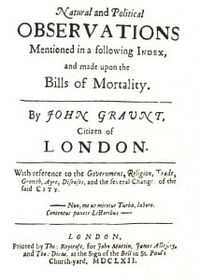John Graunt
| John Graunt | |
|---|---|
| Born |
24 April 1620 London |
| Died |
18 April 1674 London |
| Nationality | England |
John Graunt (24 April 1620 – 18 April 1674) was one of the first demographers, though by profession he was a haberdasher. Born in London, the eldest of seven or eight children of Henry and Mary Graunt. His father was a draper who had moved to London from Hampshire. In February 1641, Graunt married Mary Scott, with whom he had one son (Henry) and three daughters.
Graunt, along with William Petty, developed early human statistical and census methods that later provided a framework for modern demography. He is credited with producing the first life table, giving probabilities of survival to each age. Graunt is also considered as one of the first experts in epidemiology, since his famous book was concerned mostly with public health statistics.
His book Natural and Political Observations Made upon the Bills of Mortality (1662 Old Style or 1663 New Style) used analysis of the mortality rolls in early modern London as Charles II and other officials attempted to create a system to warn of the onset and spread of bubonic plague in the city. Though the system was never truly created, Graunt's work in studying the rolls resulted in the first statistically based estimation of the population of London.
The erudition of the Observations led Graunt to the Royal Society, where he presented his work and was subsequently elected a fellow. Initially, members of the Royal Society wanted nothing to do with Graunt, uncomfortable with the idea of a haberdasher being elected. Fortunately for Graunt, Charles II, who was King Of England at the time, ignored their objections and brought Graunt into the society.
Upon entering into the Royal Society,[citation needed] Graunt decided to convert to Catholicism at a time when Catholics and Protestants were struggling for control of England and Europe. Due to his association with the religion, he was accused of taking part in the Great Fire of London[citation needed] and as a result was dismissed from his employment at a water company.[citation needed] With no financial support, Graunt lived the rest of his life in poverty, dying of jaundice and liver disease at the age of 53.
Tribute to Graunt's pioneering work was paid by Sir Liam Donaldson on the tenth anniversary of the Public Health Observatories.[1]

See also
References
- ↑ "Speech by Chief Medical Officer regarding the ten year anniversary of the Public Health Observatories". Retrieved 13 March 2012.
External links
- John Graunt (1620-1674), Text of the "Observations" and other Graunt materials are available on Western Washington University.
|